AEK-971, modernized Garev-Koksharova machine gun
AEK-971 is a promising machine, a continuation of AEK with the exact same principle of operation, in fact AK-107 / 108 has become. But the recognition of the Soviet gunsmiths this machine has not acquired.
In August, 1981, the Soviet gunsmiths, as part of the development work on the topic “Creating an automatic machine, 1,5 is twice as efficient as the AK-74 automatic machine”, better known as “Abakan”, began to actively develop promising automatic weapons. When creating a new machine, the main task was to increase the accuracy of 5-10 times with continuous fire to increase the accuracy of shooting even among inexperienced young soldiers. The new weapon being developed on the Abakan theme was to preserve all the fighting qualities of its predecessors, first of all, the reliability of the ability to be installed in all existing military equipment facilities, to allow all regular components to be attached to it: a bayonet, a rifle grenade launcher, optical instruments and so on. .d
All the leading gunsmiths and designers of the USSR took part in this competition "Abakan" for the development of a new machine gun.
In 1984, twelve automaton projects were submitted to the competition. From the presented samples, nine projects among which were a Garev-Koksharova 5,45-mm AEK-971 machine with a non-impact scheme and balanced automatics reached the testing stage.
Balanced automatics is the main distinguishing feature of the AEK-971 automaton design; this scheme is created on the basis of a gas engine (similarly to the AK-107 / AK-108 automata). In this scheme, an additional gas piston associated with the anti-mass moves synchronously with the main, displacing the bolt carrier, but towards it, thereby compensating for the pulses arising during the motion of the bolt group and during its impacts in the rear and front positions. As a result of the use of such a scheme when firing bursts machine does not twitch. And precisely because of this scheme in the AEK-971 machine gun, the accuracy of automatic firing by bursts is two times better than that of AK-74 and AKM.
In AEK-971, cartridges were powered from a standard 30 magazine with cartridges from AK-74. The barrel is locked by turning the bolt. The butt was cast around on the left side of the receiver. The translator-fuse box was displayed on both sides of the receiver, the box located on the left side did not have a fuse function, which somewhat reduced its capabilities.
A distinctive feature of the first model AEK-971 was an unusual modular device. The design of this muzzle brake-compensator was based on a completely new concept of firing by the shooter from stable and unstable positions. When conducting automatic firing with bursts from unstable positions: standing, on the move, from the knee, it was possible to reduce the holes in the muzzle brake-compensator with a special lever located on the left side of the receiver, when shooting from stable positions: lying from the stop, sitting from the stop, standing with a stop, respectively, it was possible to increase them. The use of a change in the diameter of the holes for the powder gases flowing into the muzzle brake-compensator together with the balanced automatics made it possible to achieve even greater stabilization of the weapon during automatic firing.
The AEK-971 trigger mechanism allowed for single and automatic fire and fire with fixed bursts of two shots, which greatly increased the effectiveness of firing from this machine gun at a rate of firing 1500 shots per minute.
Subsequently, the design of this machine has been significantly simplified. At the insistence of representatives of the Ministry of Defense, the adjustable muzzle brake-compensator was replaced with a standard muzzle brake-compensator from the AK-74 submachine gun, which significantly reduced the rate of firing of the submachine gun. Butt became permanent and almost complete alteration was subjected to a bed.
The upgraded Garev-Koksharov machine showed results when firing continuous fire, with the 15 20% surpassing the similar results of the standard 5,45-mm Kalashnikov AK-74 assault rifle. But AEK-971 was inferior in accuracy to the second shot when firing automatic fire to its main rival, the Nikonov machine gun, although it surpassed it in this indicator when firing in long bursts. According to the results of the competition "Abakan", the Nikonov machine gun was adopted, later received the designation AN-94.
But on this story machine AEK-971 not over. In the late nineties, the Ministry of Defense of the Russian Federation again demanded a weapon with balanced automation that Kovrov gunsmiths worked on.
Automatic AEK-971 was again upgraded in accordance with the new requirements of MO. On the left side of the receiver a universal bracket appeared for mounting all types of optical and night sights on the machine; the bracket was installed thanks to the appearance of a new iron butt folding on the right side of the receiver. The shooting mode was also implemented in fixed bursts of three shots. The machine was launched into serial production.
The serial model of the AEK-971 machine consisted of the following main parts and mechanisms:
- barrel with receiver;
- cover the receiver;
- moving parts (shutter, bolt carrier, balance bar and carriage);
- return mechanism;
- trigger mechanism, made in the form of a separate node;
- safety guard;
- translator of fire;
- directing balancer;
- handguards;
- barrel lining;
- muzzle brake compensator;
- bayonet knife and shop;
- accessories.
The kit includes: accessory, belt and case with a pocket for the store, as well as a night rifle scope universal (NSPU).
The AEK-971 automatics is built according to the vapor scheme with a long stroke of the gas piston and an additional balance bar having its own, second gas piston moving in the opposite main direction. Synchronization of the bolt and balancer is carried out using a gear located vertically between them. The barrel is locked with a butterfly valve, similar in design to the Kalashnikov AK-74 machine gun.
The receiver AEK-971 is a casting, inside which there are cavities for accommodating the firing mechanism, magazine, accessories. To ensure the direction of movement of moving parts box reinforced steel rails. The reflector tooth is made on the left rail. A butt plate with a folding stock axle is attached to the back of the box using rivets. In the front part of the receiver with rivets attached barrel coupling. In front of the safety bracket on the axis of the fixed latch store with a spring.
The following modifications were developed on the basis of AEK-971:
- AEK-972 - AEK-971 version chambered for 5.56x45 mm NATO. In addition to the changes caused by the change of weapon caliber, there are no other structural differences from the base model.
AEK-972
Movable parts are the main mechanism of automation and consist of a bolt, bolt carrier, balance bar and carriage.
The shutter serves to send the cartridge into the chamber, close the barrel bore, break the capsule and remove the cartridge case from the chamber. The bolt consists of the bolt itself, a spring-loaded ejector with an axle, a drummer and a hammer pin.
The bolt carrier serves to actuate the bolt, balance bar and trigger mechanism. The bolt carrier consists of a frame, liner, frame rail, return spring stop. The frame is connected to the frame rail and the liner with two cylindrical fingers.
The balancer is used to balance the pulses from the movement of the bolt carrier and the shutter. The balance bar is telescopically placed inside the slide of the bolt carrier, in the front part has a threaded section for connecting the rod, which acts as a piston. In the wall of the balance bar there are longitudinal perforations for interaction with gears.
The balancer guide serves to guide the balancer. It consists of a welded tube, plug and stop.
The carriage is used to accommodate two gears, kinematically connecting the balance bar and the slide frame.
The trigger mechanism serves to control the firing of a machine gun, is designed as a separate node, contains a shock and trigger mechanism.
The fire interpreter, located on the left side of the weapon, is used to set the required shooting mode (single, automatic and with an 3 cutoff shot). It has a cylindrical part with transverse grooves for interacting with the sear of a firing mechanism and a flag for switching. AEK-971 AEK-972
AEK-973 - option AEK-971 under the Soviet cartridge 7.62x39 mm. Uses shops from the AK-47 automatic machine, in the rest the automatic machine is identical to AEK-971.
AEK-973
Caliber mm 5.45x39 5.56x45 7.62x39
Length, mm
- butt decomposed
- butt folded
960
720
Barrel length, mm 420
Weight without magazine, kg 3.3
Score,
count 30 cartridges
Initial
speed
bullets, m / s 880 850 700
Sighting
range
firing, m 1000
Rate of fire,
rpm 800 - 900
For the production of a single shot, the translator’s flag must be switched to the “OD” position, while the translator releases the trigger and the sear of a single fire. When you pull the trigger the trigger under the action of the mainspring strikes the firing pin. Drummer punctuates the cartridge primer - a shot occurs. After the bullet passes through the vent hole in the barrel, the gases rush through it into the gas chamber, act on the moving parts, sending them into a rollback. Departing back, the bolt carrier turns the bolt around the longitudinal axis and displays its lugs due to the lugs of the barrel coupling - unlocking the bolt and opening the barrel bore occurs. The sleeve is held by the ejector, bumps into the ledge of the receiver and is extracted. The slide frame, moving backwards, cocks the trigger, the trigger is captured by the sear with a single fire and the trigger remains in the rear position. Rolling of moving parts occurs under the action of a return spring. In the roll forward, the next cartridge is sent to the chamber and the barrel is locked. At the end of the free stroke, the slide frame separates the self-timer with the trigger, but the trigger is held in the cocked position with the sear's single fire, therefore the next shot does not occur. For the next shot you need to release the trigger and press it again. The cycle of the automation will be repeated.
In group fire mode (3 shot), the interaction of parts and mechanisms of the machine is similar to their interaction with a single fire; the difference is in the operation of the firing mechanism. The translator releases the trigger and the group fire sear, and the single fire sear is locked and cannot interact with the trigger. When the trigger is pressed, it turns, and together with it, the sear of group fire turns before it introduces the shank into gear with the lower teeth of the ratchet wheel. The ratchet wheel, preventing further turning of the group fire, is locked by the tail itself. At that time, the hook was hooked outside the zone of interaction with the trigger, the click is released, and the trigger moves. During the working stroke, the pusher, connected to the trigger, with its hook turns the ratchet wheel by the upper front tooth one step, and the whisper shaft locks the ratchet wheel in its new position. When cocking the hammer after a shot, the pusher moves back and grabs the next upper tooth with a hook. After three working moves of the trigger, the ratchet wheel frees the shank of the whisper and he, along with the sear, turns so that the hook of the sear gets in the way of the movement of the trigger and seizes it; A regular shot does not occur. To make the next group of shots, you must release the trigger and press it again.
To conduct automatic shooting, you need to turn the translator flag to position “A”. In automatic firing, the interaction of parts and mechanisms of the machine gun is similar to their interaction in single and group fire mode, the difference lies in the operation of the firing mechanism. When you pull the trigger the trigger is released and makes a working move. When cocking the trigger is held only by the self-timer, and upon the arrival of the bolt carrier in the forward position it is disrupted from it. Shooting continues until the trigger is pulled. When you release the trigger, the trigger gets to the combat platoon.
In the "PR" (Fuse) position, the translator locks the trigger and raises the safety guard, blocking the movement of moving parts.
Combat fire rate of the automaton when shooting with single shots is 40 shots per minute, while firing bursts - up to 100 shots per minute.
Due to the design features of the trigger mechanism in the AEK-971 machine gun, the possibility of involuntary reloading of the weapon with the safety switch off when the butt hits on a hard surface is almost completely excluded.
AEK-973
The cover of the receiver protects parts and mechanisms inside the receiver from contamination. On the right side it has a stepped notch for the passage of the sleeves ejected to the outside and for the movement of the bolt carrier. Fastening is carried out by a swivel check.
The barrel is fixed to the muzzle brake compensator, which serves to reduce the flames and sound when fired and increase the accuracy of the battle when firing in bursts.
The mechanical sighting device of the sector type is structurally similar to the AK-74. Aiming range of fire from the machine - 1000 m. In addition, on the left side of the receiver is a universal bracket for mounting on the machine of various types of collimator, optical and night sights.
AEK-973 - version AEK-973, equipped with a retractable telescopic butt. When the butt is removed, the shoulder rest closes with the pistol grip, forming a streamlined design and without complicating the shooting. Changed the shape and angle of the pistol grip. Due to the design features of the modified trigger, the translator-fuse lever is located on the right side of the receiver.
AEK-973С
To supply the machine used regular stores from the AK-74 with a capacity of 30 cartridges, and it is also possible to use shops from the Kalashnikov RPK-74 light machine gun (RPK-74М) with a capacity for 45 cartridges.
For the purpose of convenience when carrying the machine has a lightweight butt of the frame type folding on the right side
Handguard, pistol grip, barrel lining of the gas tube are made of impact-resistant plastic.
Plastic pistol grip zatselo made with trigger guard.
The machine is equipped with mounts for staffing bayone-knife 6X4 and grenade launchers GP-25, GP-30, GP-34.
AEK-971 submachine guns were produced in small batches and were in service with special forces of the Ministry of Internal Affairs and other law enforcement agencies. In the 2006 year, at the Kovrovsky Machine-Building Plant, the production of military products was completely discontinued. All production was transferred to the Degtyarev Kovrov Plant (ZiD), but the deployment of the production of AEK-971 series machines to ZiD was suspended, and the establishment of production required large upfront costs that could pay off only if large orders were received for the new machine.
- http://topwar.ru"rel =" nofollow ">http://topwar.ru
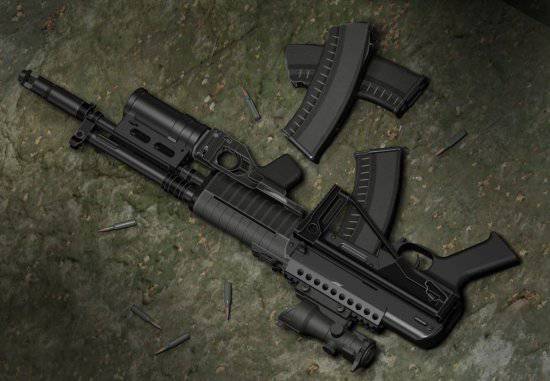
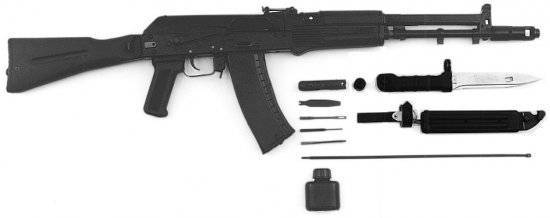
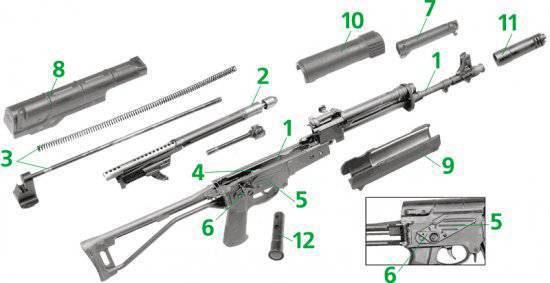
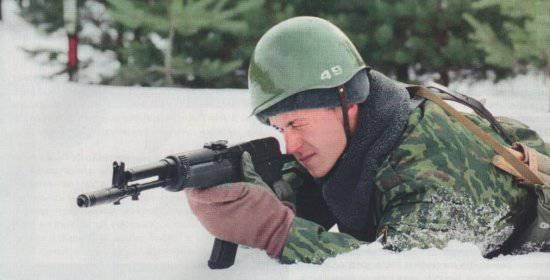
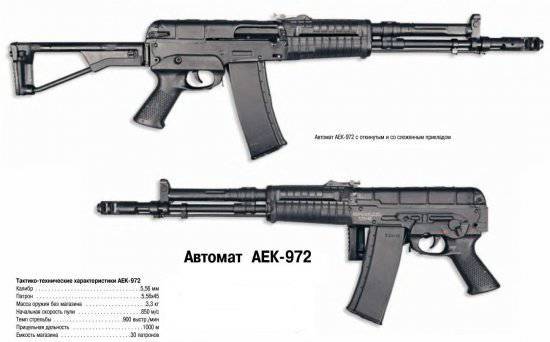
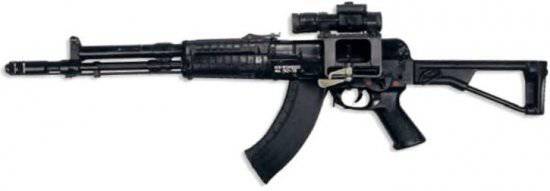
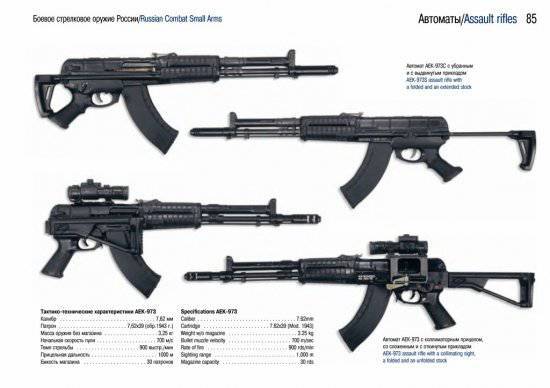
Information